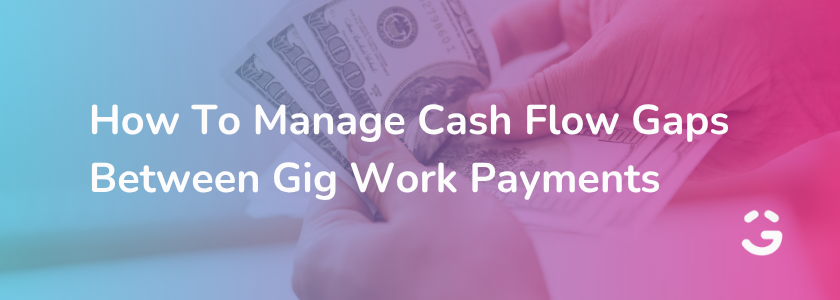One of the best parts of gig work is the freedom it offers. You set your own schedule, pick your clients, and in some cases, decide your own rates. But that flexibility comes with one big challenge: managing cash flow for gig workers.
Unlike traditional jobs with steady paychecks, gig workers often face unpredictable income. One week might bring a steady stream of gigs, while the next could leave you waiting for delayed payments or struggling to pay bills. That stop-and-go income cycle makes financial planning for the gig economy especially tricky.
If you’ve ever wondered how gig workers handle cash flow or keep their budget intact between payouts, you’re not alone. The good news is, there are practical ways to stay ahead. In this blog, we’ll share simple strategies, helpful tools, and flexible funding options to help bridge those gaps, improve income tracking for gig workers, and give you more stability, no matter how inconsistent your schedule gets.
Key Takeaways
- Budgeting is harder when your income isn’t predictable. Gig work gives you freedom, but delayed payments, inconsistent schedules, and platform payout limits can throw off your cash flow if you're unprepared.
- Simple tools make a big difference. Budgeting spreadsheets, income tracking apps, and early payout features on gig platforms help you stay organized and avoid surprises.
- When cash runs short, gig-friendly financing can help. Short-term advances with no hard credit checks offer a fast way to cover essentials like rent, groceries, or fuel without the long wait or stress of traditional banks.
- The most successful freelancers plan ahead. From building an emergency fund to stacking gigs based on payout schedules, small habits like automating savings and setting income goals can help create more stable, long-term cash flow.
Why Cash Flow Is a Real Issue for Gig Workers
Gig workers often run into delays accessing their pay, even after the work is done. These slowdowns make it harder to cover everyday costs and keep finances on track.
Variable Pay Schedules
One of the biggest hurdles in how gig workers handle cash flow is not knowing when or how much they’ll get paid. You might make $1,000 one week and struggle to earn $200 the next. It depends on job volume, client demand, and how quickly payments are cleared. This inconsistency makes it hard to budget for recurring expenses like rent, fuel, and food, let alone plan ahead or build savings. For many, bridging those uneven weeks is a constant juggling act.
Client Payment Delays
Freelancers and independent contractors face a different kind of delay: invoices. Even when you’ve set clear terms, waiting two to four weeks—or more—is not uncommon for a client to pay up. That delay leaves a gap between when the work is done and when the money shows up. Without proper income tracking for gig workers, these delays can spiral into late fees, missed payments, or the need to dip into savings to stay afloat.
Platform Withdrawal Rules and Limits
Even gig apps with instant pay options don’t always solve the problem. Platforms like Uber, DoorDash, or Instacart might let you cash out earnings the same day, but there’s usually a fee, a limit on how many times you can withdraw, or a cap on how much you can access at once. That means it's not always immediately available even when you’ve earned the money. For those working across multiple platforms, these restrictions can complicate financial planning for gig economy workers.
If you’re looking for ways to manage these unpredictable payments, exploring funding options built for self-employed workers can give you a reliable backup plan when your income doesn’t arrive on time.
How Gig Workers Handle Cash Flow Today

Gig workers face income that can change daily, so staying on top of money requires flexibility and quick decision-making. Many now use a mix of tools and strategies to keep cash flow for gig workers steady.
Manual Budgeting or Spreadsheets
Many gig workers still rely on old-school budgeting systems like spreadsheets or envelope tracking. These tools help with income tracking for gig workers, giving them visibility into spending, saving, and what’s due. It may take time, but it’s one way to stay ahead when pay varies weekly.
Freelancers Using Early Payout Features or Invoice Tools
Some platforms now let freelancers access money early, for a small fee. Others use invoice tools that support upfront deposits or send reminders to speed up client payments. These features have become essential in how gig workers handle cash flow, especially when waiting on late invoices.
Using Advances and Payday Loans to Fill Gaps
When all else fails, some gig workers rely on advances, payday loans, or instant financing. While not ideal long-term, they offer a quick fix during tight weeks. Flexible lenders catering to the self-employed make it easier to bridge gaps without the delays or red tape of traditional banks. These options are becoming part of real-world financial planning for gig economy workers.
Tools for Tracking Income as a Gig Worker
With different clients, apps, and schedules, it’s easy to lose track of how much you’re really earning. That’s why income tracking can help you gain visibility and control of your finances.
Income Tracking Apps
Apps like QuickBooks Self-Employed, Everlance, and Hurdlr make managing earnings from multiple platforms easier. They track deposits, sort expenses, and even log mileage for taxes. These tools are often the first step in how gig workers handle cash flow more efficiently.
Connecting Bank Accounts to Monitor Inflows
Syncing your bank accounts with a tracking app gives you real-time updates on your finances. This is especially useful when juggling multiple apps and freelance gigs, where payments can land at different times. Automated syncing means you won’t miss a deposit or overlook a business-related expense.
It also simplifies how gig workers handle cash flow from week to week. With built-in alerts and summaries, you’ll have better visibility of when you can afford to take a break and when it’s time to hustle harder to meet your financial goals.
Weekly and Monthly Cash Flow Reports
Short-term cash flow reports help you make small adjustments before things spiral out of control. A weekly snapshot might show you're spending too much on gas or that a client is consistently late paying invoices. On the flip side, monthly reports help identify income trends, which is key for smarter financial planning for gig economy workers.
Regularly reviewing your reports allows you to plan around slower months, identify which gigs or clients are most profitable, and stay on track with savings or tax contributions. This kind of insight helps turn unpredictable income into something you can work with.
Forecasting Future Earnings
Some advanced apps offer forecasting tools based on your past income patterns. These tools use your history to predict what you might earn in the coming weeks or months. It’s not always 100% accurate, but it gives you a helpful estimate, especially when you're trying to plan big purchases or set aside money for taxes.
Forecasting also supports better financial planning for gig economy workers who don’t get a steady paycheck. It helps you smooth out the highs and lows so you can set budgets, avoid shortfalls, and plan for business investments or time off with more confidence.
Financial Planning for the Gig Economy: What to Do Monthly

Financial planning for the gig economy should be a monthly habit, not something you only think about during tax season or a cash crunch. With a few simple tips, you can avoid stress and keep your finances steady.
Set Aside for Taxes and Slow Seasons
Most gig economy jobs don’t withhold taxes, so you’ll need to handle that yourself. A good habit is to save 20%–30% of your income for taxes each month. If you have a solid month, use the extra to pad your emergency fund or prepare for slower seasons.
Plan Monthly Essential Costs First
Your basics—like rent, groceries, fuel, and subscriptions—should be the first items you budget. Knowing your monthly non-negotiables gives you a clear income target. Once those are covered, you can decide what to do with any extra: pay off debt, reinvest in gear, or stash more into savings.
If you’re short before payday, a $500 loan or a quick $1000 cash advance can fill the gap. Just make sure it’s a short-term fix, not a long-term habit.
Create Buffer Savings
Even setting aside $25 or $50 a week makes a difference. Over time, you’ll build a buffer that helps you stay calm during dry spells or when unexpected costs pop up. Start with one month’s worth of expenses—then work toward three.
This is one of the most overlooked yet effective parts of financial planning for the gig economy.
Automate Savings Transfers
Make it automatic. Set up recurring transfers from your checking to savings, even if it’s just a small amount. You’ll be surprised how fast it adds up when you’re not thinking about it, and you won’t be as tempted to spend it.
Smart Ways to Handle Gaps Between Payments
Payment schedules aren’t always predictable in gig work, but your bills are. Instead of stressing over delays, here are a few smart strategies gig workers use to stay afloat when money hasn’t hit their account yet:
Use Short-Term Financing as a Buffer
When money's tight, a quick cash boost can help cover rent, fuel, or groceries. Many gig workers use short-term loans or cash advances with no hard credit check to bridge the gap. Just be sure to choose a low-risk option and use it as a temporary fix, not a habit.
Ask for Faster Payments or Use Same-Day Payout Apps
If you’re freelancing, try negotiating Net 7 or same-day payments with reliable clients. For rideshare or delivery work, switch to gig apps that pay daily so you’re not waiting days for your money. Getting paid faster makes it easier to stay ahead of your bills.
Build Emergency Savings (Even Small Ones)
You don’t need a huge savings account. Even setting aside $20–$30 a week adds up. A small emergency fund of $100–$300 can cover surprise bills or hold you over until the next payout. It’s one of the smartest ways to smooth out gig worker cash flow over time.
Align Your Work Schedule With Payout Timing
Different platforms pay at different times—some daily, some weekly. Plan your schedule so you’re always working with cash flow in mind. For example, stack daily-pay gigs at the start of the week, then move into weekly-pay clients later. This helps you avoid going too long between paychecks.
When to Use Gig-Friendly Financing
There’s no shame in needing help between paychecks. Even seasoned freelancers and gig workers experience slow periods. That’s exactly why gig-friendly financing exists—to give you quick access to funds when you need them most.
Here’s when it makes sense to use it:
Covering Delayed Invoices or Client Payments
Freelancers are often stuck waiting weeks—or even months—for clients to pay up. Meanwhile, rent, bills, and subscriptions don’t wait. In situations like this, a small advance can help bridge the gap until the money hits your account.
Dealing with Seasonal Dips
Work tends to slow down during certain months, but your expenses stay the same. Gig-friendly financing helps cover those slower periods so you can keep things running without draining your savings.
Investing in Tools to Keep Income Flowing
Sometimes you need to spend money to make money. Whether it's buying new equipment, upgrading your internet, or paying for a platform subscription, financing gives you a way to invest in your business, even if your cash flow is tight that week.
Taking Advantage of Last-Minute Gigs
Some of the best opportunities pop up fast. Maybe a high-paying project needs a quick turnaround, or there's an event that requires extra drivers. Gig-focused funding can cover gas, materials, or other upfront costs so you don’t have to miss out.
Long-Term Cash Flow Tips That Actually Work
Daily earnings are important, but long-term stability comes from strategy, not just hustle. If you want to grow beyond short-term survival, these tips can help you create a more predictable income and stay one step ahead.
Diversify Your Income Streams
Putting all your eggs in one basket is risky. Apps change their policies, clients disappear, and demand fluctuates. To protect your income, build more than one stream. You could combine food delivery during the day with freelance work at night, or balance ride-share gigs with weekend events. Not sure where to start? Here’s a helpful guide to diversifying your self-employed income.
Reinvest in Tools or Skills That Pay Off
Use a portion of your earnings to upgrade tools or learn new skills. Whether it’s better gear, a course on SEO or design, or joining a premium platform, the right investment can boost your rates and open up higher-paying opportunities.
Forecast Your Income Like a Business
Think a few months ahead. Use a simple spreadsheet or budgeting app to map out your expected income and expenses for the next 3–6 months. This helps you spot slow periods early and prepare before they hit.
Set Clear, Measurable Milestones
Goals are easier to hit when they’re specific. Instead of saying “I want to earn more,” try “I want to save $500 for insurance by November” or “Bring in $300 this month from a new gig app.” Milestones keep you focused and motivated.
Build a Safety Net, Even If It’s Small
Start with whatever you can—$10, $20, or $50 a week—and set it aside in a separate savings account. Over time, this becomes your go-to buffer when gigs are slow or unexpected expenses pop up.
The gig economy may be unpredictable, but with the right habits and long-term thinking, you can build a more stable, stress-free income over time.
Final Thoughts
Cash flow for gig workers isn’t always steady, but that doesn’t mean it has to be stressful. The key is preparation. With smart planning, the right tools, and flexible funding options, you can handle income gaps without missing a beat.
Track your earnings, plan ahead for slow weeks, and use financing options that fit your lifestyle. A little effort now can lead to a more stable, confident future.
Need a boost between gigs? Apply with Giggle Finance to get fast, flexible funding designed for freelancers like you.
Disclaimer: Giggle Finance provides Revenue-Based Financing programs for business purposes only. Any mention of any loan product(s), consumer product(s), or other forms of financing is solely for marketing and educational content purposes and to help distinguish Giggle’s product from other comparable financing options available in the market.
